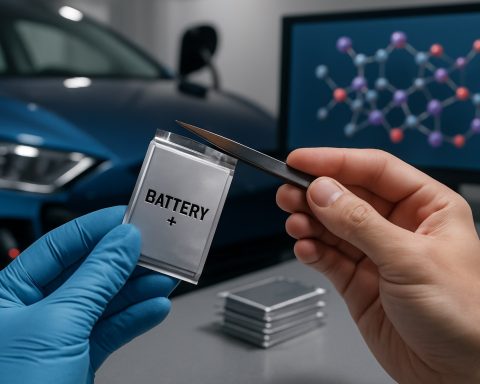- Lansing, Michigan, welcomes a new era with a major battery manufacturing facility led by LG Energy Solution (LGES).
- The near-complete Ultium battery plant in Lansing, previously a joint venture with GM, highlights over $2 billion in investment, signifying its role in Michigan’s economic vitality.
- LGES’s ownership shift underscores confidence in Michigan’s potential for advancing battery technologies.
- The facility promises at least 1,360 stable, well-compensated jobs, reinforcing the region’s employment landscape.
- The project’s construction has attracted local talent and fueled significant employment, boosting Lansing’s tech corridor.
- LGES plans to leverage Michigan’s automotive history and skilled workforce to spearhead the clean energy transition in North America.
- The facility’s strategic investment promises economic resurgence and positions Lansing as a key player in electrification and energy efficiency.
A new chapter unfurls in Lansing, Michigan, where a colossal battery manufacturing facility envisions a future powered by volts and watts, rather than pistons and petrol. With the recent transition of ownership solely to LG Energy Solution (LGES), the stakes are higher, ensuring the region remains a beacon of innovation in the ever-evolving automotive industry.
The skyline of Lansing whispers tales of transformation. The near-complete Ultium battery plant stands as a futuristic fortress, nearly 98% finished and dripping with anticipation. The plant, originally a joint venture between auto giant General Motors (GM) and LGES, has seen over $2 billion poured into its construction, marking it as a cornerstone of economic vitality for Michigan’s capital. The handover of GM’s stake to LGES signifies more than just an ownership shift—it is a bold declaration of confidence in Michigan’s fertile ground for cutting-edge battery technologies.
The vision remains clear: At least 1,360 stable and well-compensated jobs will be safeguarded, a firm promise from LGES. The facility not only safeguards these roles but also strengthens the landscape for future employment opportunities. Notably, as LGES takes the helm, it accelerates its commitment to cell production that could reshape the nation’s approach to energy storage and electric vehicle technology.
On Lansing’s streets, the echoes of construction phases, buzzing with activity from a skilled cadre of workers, resonate with optimism. This facility’s genesis has not only fueled substantial local employment but has also attracted considerable talent, eager to anchor themselves in Michigan’s burgeoning tech corridor. The vibrant hum of ongoing work infuses the atmosphere with a sense of forward momentum, one that has the potential to ripple across the region and beyond.
LGES’s commitment extends beyond the immediate milestones of the facility. The company ambitively aims to leverage Michigan’s strategic advantages. Its rich history within the American auto industry, coupled with a dynamic workforce, places the state as a pivotal player in the clean energy transition. The investment in Lansing serves as a strategic fulcrum for LGES, amplifying its position in the North American market and reinforcing its vision for the future.
A palpable enthusiasm envelops stakeholders and residents alike. This innovative push promises not just economic resurgence but serves as a lodestar for aspiring industries looking towards sustainable and diversified energy solutions. The Lansing facility’s unwavering commitment and strategic investment could very well be the linchpin in transforming America’s automotive heartland into a new powerhouse of electrification and energy efficiency.
In this bold new era, Lansing stands not as a singular triumph but as a testament to the resilience and foresight needed for future prosperity.
The Power Surge: Exploring Lansing’s New Battery Facility and Its Impact
Overview of Lansing’s Battery Facility Transformation
The transformative development in Lansing, Michigan, marks a significant milestone in the global shift towards sustainable energy solutions. The newly established battery manufacturing facility, once a joint venture between General Motors (GM) and LG Energy Solution (LGES), is now fully under LGES’s ownership. This move signals a strong commitment to advancing battery technology and fostering economic growth in Michigan.
1. How the Facility Transforms Michigan’s Economy
The $2 billion investment in Lansing’s Ultium battery plant is set to provide long-term economic benefits. The creation of at least 1,360 stable jobs is just the beginning. By accelerating cell production, LGES is poised to stimulate additional industries, from logistics to research and development, anchoring Michigan’s position as a leader in the clean energy sector.
2. Future Prospects of the Battery Industry
As the demand for electric vehicles (EVs) increases, the battery industry is expected to surpass $84 billion by 2027, according to market research reports like those from Grand View Research. This facility plays a crucial role in meeting this demand, positioning Lansing at the forefront of this economic and technological evolution.
3. Pros and Cons of the Transition to LGES Ownership
Pros:
– Focused Management: With LGES solely at the helm, decision-making is streamlined, enhancing operational efficiency.
– Increased Investment in Innovation: LGES’s deep expertise ensures continued advances in battery technologies.
– Local Economic Growth: Jobs and secondary markets burgeon, providing substantial economic impetus.
Cons:
– Transition Challenges: Shifting ownership can lead to initial operational hiccups.
– Dependence on a Single Entity: A monopoly on facility ownership can risk future adaptability.
4. Real-World Applications and Innovations
The products of this facility will power an extensive range of applications beyond EVs, including backup power solutions, grid stability systems, and personal electronics. These innovations support a greener grid and create localized energy independence.
5. LGES’s Strategic Advantage and Sustainability Focus
LGES’s extensive history in the automotive industry, especially within North America, complements Michigan’s storied past in automobile manufacturing. The facility’s operation focuses on sustainability, utilizing cutting-edge recycling processes and minimizing carbon footprints.
6. Potential Controversies and Limitations
While the facility heralds substantial growth, concerns such as supply chain disruptions, raw material shortages, and geopolitical tensions could impede progress. Sustainable sourcing of lithium and cobalt remains a pressing priority, highlighting the need for robust, ethical supply chains.
Actionable Recommendations
1. Stay Informed: Industry stakeholders and the public should track developments in battery technology and market trends to anticipate shifts.
2. Explore Energy Solutions: Local businesses and consumers might consider investing in battery technologies for energy security and efficiency.
3. Participate in Community Inputs: Residents can engage in community forums to contribute to the economic strategies and sustainability discussions surrounding such projects.
4. Embrace Eco-Friendly Practices: As consumers, supporting companies that prioritize sustainable practices aids in the larger movement towards a renewable future.
By leveraging its strategic location and resources, LGES in Lansing represents a blueprint for regions aiming to transition into leaders in clean energy technology.
For more on similar advancements in the automotive industry, visit LG Chem and GM.










